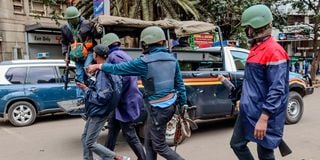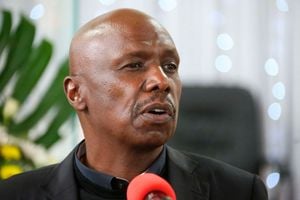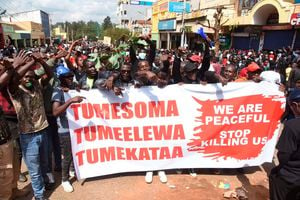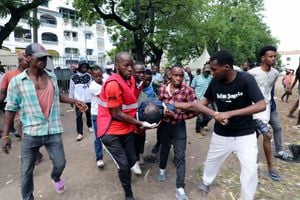
Police officers arrest a protester on Kenyatta Avenue in Nairobi during anti-Finance Bill protests on June 27, 2024.
Following widespread anti-Finance Bill protests, President William Ruto on Wednesday reaffirmed his campaign promise to end State-instigated abductions as a political tool amid a wave of disappearances.
A few hours later, Kenya School of Law President Joshua Okayo sent a distress message to his close friends before his phone was switched off.
He was abducted at 7pm on Wednesday by men identifying as Directorate of Criminal Investigations (DCI) officers as the crackdown on people believed to be behind the protests that rocked at least 35 of the 47 counties continued.
Around the same time, University of Nairobi student leader Peter Nyamweya Oginga was also picked up. Their fates are not isolated, as dozens of other individuals have been abducted by plainclothes law enforcers in an operation reportedly orchestrated by DCI and National Intelligence Service (NIS) officers.
They all had one thing in common – they have been vocal on the anti-Finance Bill protests to the point that State bureaucrats believe they are among organisers or coordinators of the civil unrest.
The Law Society of Kenya places the number of those abducted over the protests in the past week at over 50 – more than three times the total number of enforced disappearances in all of 2023.
Enforced disappearances
Interestingly, President Ruto had said that there have been no enforced disappearances in his time as Head of State, before turning around to claim that all abducted individuals had been released.
At the time of his address, popular artiste Kasmeul McOure was still in custody as the LSK and other civil society groups sought his whereabouts.
In the case of political activist and satirist Gabriel Oguda, the LSK and his family were forced to run after vehicles that were moving him across different towns. Mr Oguda was eventually released after being traced to Kajiado.
"Pray for Osama & the rest who were abducted, it's never easy at the hands of those bloody animals. Many won't talk but they really do you dirt…,” George Diano, one of the first abductees tweeted on Wednesday. He then detailed some of the trauma he has undergone even after being released.
Police Reforms
“I'm not hiding anymore; I've run out of energy & finances trying to fight for what is right. I'm not switching off my phone as advised by the HRC, I have already lost hope in life. Our people have died & more will die if we stop calling out the atrocities. May God protect Us!” Mr Diano said.
On Tuesday, the Police Reforms Working Group documented at least 22 abductions, 50 arrests, 300 injuries and 23 deaths, all at the hands of the police.
The protests, attended by thousands of Kenyans, have since seen President Ruto make the unprecedented move of deploying the Kenya Defence Forces to assist quell the open dissent.
But even as President Ruto ponders the cards on his table, the mass abduction and torture of people suspected to be critical to the protests has revived horrific memories from regimes gone by when State officials kidnapped and killed dissenters willy-nilly.
Despite the existence of six institutions and numerous legislation outlawing State-instigated kidnap, torture and killings, Kenya still struggles with eradicating extra-judicial methods in politics and governance.
And the State-sponsored terror has been a vital repression tool for successive governments over the years.
Musaite Ole Tunda was herding his cows on March 2, 1975 when he came across a mutilated human body in the Ngong Hills.
A few days earlier, then Vice President Daniel Arap Moi had told the National Assembly that popular Nyandarua MP Josiah Mwangi Kariuki had chartered a flight to Zambia where the legislator was alive and well.
Mr Kariuki’s family had reported him missing to the police. It would turn out that the body Mr Tunda found was Kariuki’s remains.
The MP had been tortured – his tongue and eyes were missing, private parts and fingertips had been cut off and his face was disfigured using acid.
Sway political opinions
And just like that, Kenya had waded into the realm of using kidnap, torture and even death to sway political opinions of the public.
In February, 1990 Foreign Affairs minister Robert Ouko was violently picked up by State operatives from his home and was never seen alive again.
By this time, Mr Moi had succeeded President Jomo Kenyatta and was 12 years into his term. Many, locally and internationally, saw Dr Ouko as a potential successor when President Moi would finally leave office.
But this was not to be as Dr Ouko was picked up by unknown gunmen in the wee hours of February 13, 1990. The day would see a repeat of the script in Mr Kariuki’s tragic saga.
Dr Ouko, who was that morning officially considered missing, was found dead at the foot of a hill by a herdsman.
In this case, Joseph Shikuku found Dr Ouko’s mutilated body at the foot of Got Alila in Muhoroni. And much like Mr Kariuki, Dr Ouko had clearly been tortured before being killed.
Though exact figures are not well documented, the number of enforced disappearances, torture and murder instigated by politically connected individuals rose sharply during President Moi’s 24-year reign.
British tourist Julie Ward, outspoken clergymen Alexander Muge and John Kaiser and student leader Titus Adungosi became just a few of many other people who were abducted or killed during President Moi’s regime, with ensuing cover-up attempts.
Opposition figures like Kenneth Matiba, Raila Odinga, Koigi wa Wamwere and several others were abducted and kept incommunicado for several days, and at times weeks, irking civil society groups and Western government like the US and UK.
During President Mwai Kibaki’s term, which promised a change in how things would be done, Kenya witnessed one of its worst spontaneous spikes in enforced disappearances.
Following Mr Kibaki’s contested election win in December, 2007 violent protests broke out across the country.
During and after a peace deal that saw Odinga become Prime Minister in a power sharing arrangement, the scourge returned spontaneously.
The Kenya National Commission on Human Rights documented over 300 killings and enforced disappearances instigated by the government.
Kenya’s next two Presidents – Uhuru Kenyatta and William Ruto – were charged at the International Criminal Court for alleged human rights violations during the post-election violence.
Their cases were, however, dropped for lack of evidence or reliable witnesses. Several people lined up to testify went missing, as some recanted their statements.
While the total number of enforced disappearances throughout Kenya’s history has never been documented, the number is certainly in the thousands.
In some instances, State security organs have used these extra-judicial tactics to avert serious crimes, a move that has constantly attracted criticism and debate on the rule of law.
The Kenya National Human Rights Commission (KNHRC) has documented 82 enforced disappearances in the last five years alone.
The abductions from the anti-Finance Bill protests could now be higher than the total number documented by the KNHRC in the last five years combined.








